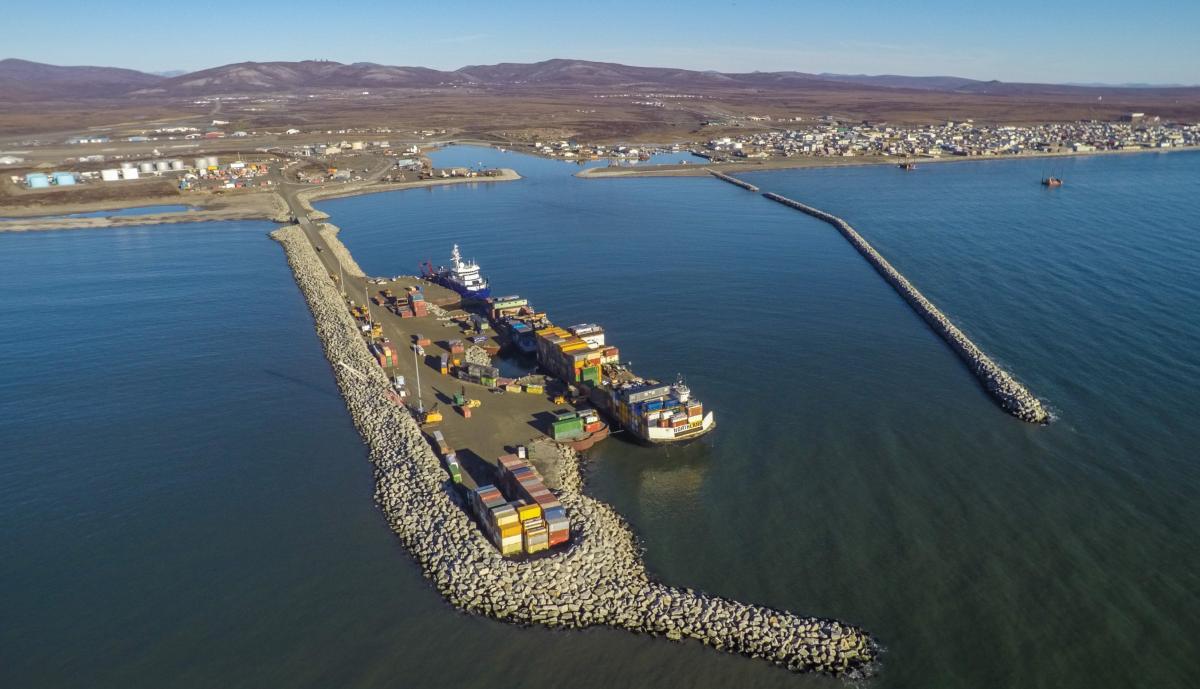The United States has no major deep-water port from Dutch Harbor in the Aleutian Islands to the U.S.-Canada border in the Beaufort Sea, a region defined in federal law as the U.S. maritime Arctic. This presents a major strategic challenge for the nation. The distance by sea from Dutch Harbor to Prudhoe Bay, located on Alaska’s North Slope, is 1,535 nautical miles—along a remote and shallow coastline with few deep-water areas. There is no safe harbor along the entire western and northern coasts of Alaska where a major combatant, Coast Guard icebreaker (or large cutter), NOAA survey ship, or any other deep-draft government or commercial ship can moor alongside a wharf.
The absence of a deep-draft Arctic port and associated marine infrastructure is a glaring gap in the United States’ ability to respond to greater marine access and activity at the top of the world. Every other Arctic coastal state, including Canada, Iceland, Denmark (Greenland), Norway, and Russia, has at least one port where a large, deep-draft ship, such as a commercial resupply carrier or naval vessel, can safely moor during Arctic operations.
Conferences and stakeholder meetings have been held since 2008 on the need for developing a set of U.S. ports in the Alaskan Arctic. The focus of these efforts and a major assessment released in 2013—the Alaska Deep-Draft Arctic Port System Study, led by the U.S. Army Corp of Engineers and Alaska state transportation department—has been on future regional and state economic benefits from the global export of Alaska’s natural resources.
One of the limitations for potential deep-water ports in Arctic Alaska is the lack of road and rail connections from the coast to the interior and major cities such as Fairbanks and Anchorage. Another constraint is the December-to-May sea ice cover in the northern reaches of the U.S. maritime Arctic.
The Port System Study identified 11 potential coastal sites for a deep-water port, with four locations selected for further study: Nome, Port Clarence (a deep-water site north of Nome), Cape Darby (a deep-water site south of Nome), and Utqiagvik (Barrow, the northernmost U.S. city). Nome and Port Clarence were selected for feasibility analyses.
The City and Port of Nome are located on the southern coast of the Seward Peninsula facing the Bering Sea, within the Bering Strait region. The Bering Strait is the key international waterway linking the Pacific and Arctic oceans, and Nome’s central location in western Alaska near the Strait is a critical factor in assessing its future role as an Arctic port. The port, with a modest 22-foot basin depth, lies 102 miles south of the Arctic Circle and 160 miles from the Russian coast. The City of Nome is a vibrant community of 3,600 people, has a modern hospital and major airport, is a commercial fishing port, and serves as a regional economic and supply hub for some 50 coastal communities in western and northern Alaska.
The Army Corps of Engineers and the City of Nome recently have been engaged in a cost-sharing, collaborative port-modification feasibility study and environmental assessment for expanding the port. The draft report released in May 2019 indicated that 14 options were evaluated, including a no-action or change alternative. One option comes close to addressing U.S. Arctic national security requirements: creation of a deep-water basin with 30- and 40-foot depths and docks along an extended breakwater and causeway. This plan may not be robust enough, and a 45-foot depth could be necessary to provide more flexibility and safety for deeper draft ships. Whatever expansion is chosen, Congress will need to fund these port modifications as key strategic maritime assets to enhance U.S. Arctic presence.
Recently, Congress has taken a keen interest in Arctic port issues. The National Defense Authorization Act (NDAA) for 2020 has a provision for designating sites for a strategic Arctic port. A report is to be submitted by the Secretary of Defense to Congress (180 days after the NDAA is enacted) evaluating potential sites for one or more strategic Arctic ports.
The Port of Nome is the logical and cost-effective location to begin developing an Alaskan Arctic port system and providing an initial place for mooring deep-draft ships. Expanding Nome is a strategic first step in providing the United States with a timely and visible port presence in its maritime Arctic to support national security and economic interests.



